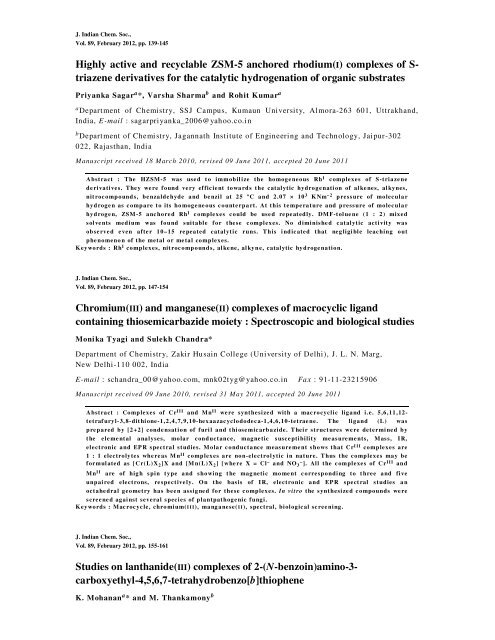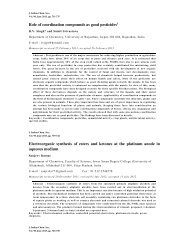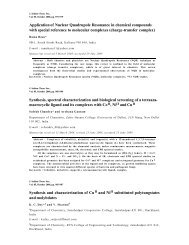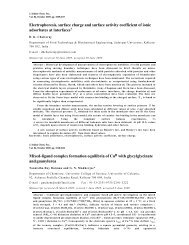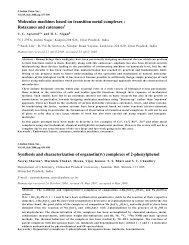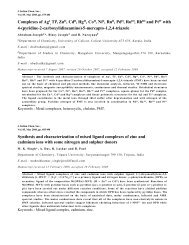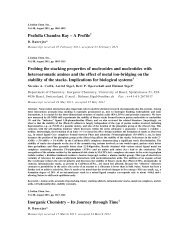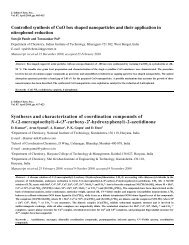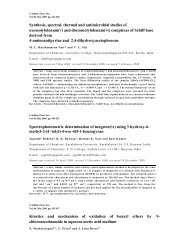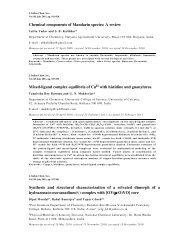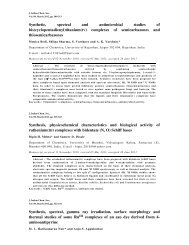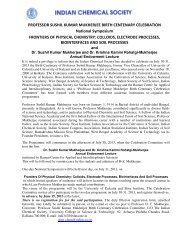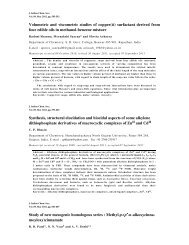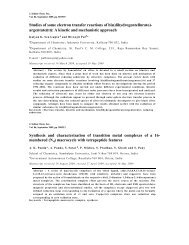Abstracts of Journal of Indian Chemical Society Vol.89, February ...
Abstracts of Journal of Indian Chemical Society Vol.89, February ...
Abstracts of Journal of Indian Chemical Society Vol.89, February ...
Create successful ePaper yourself
Turn your PDF publications into a flip-book with our unique Google optimized e-Paper software.
J. <strong>Indian</strong> Chem. Soc.,Vol. 89, <strong>February</strong> 2012, pp. 139-145Highly active and recyclable ZSM-5 anchored rhodium(I) complexes <strong>of</strong> S-triazene derivatives for the catalytic hydrogenation <strong>of</strong> organic substratesPriyanka Sagar a *, Varsha Sharma b and Rohit Kumar aa Department <strong>of</strong> Chemistry, SSJ Campus, Kumaun University, Almora-263 601, Uttrakhand,India, E-mail : sagarpriyanka_2006@yahoo.co.inb Department <strong>of</strong> Chemi stry, Jagannath Institute <strong>of</strong> Engineering and Technology, Jaipur-302022, Rajasthan, IndiaManuscript received 18 March 2010, revised 09 June 2011, accepted 20 June 2011Abstract : The HZSM-5 was use d t o immobil ize the homoge neous Rh I c omplexes <strong>of</strong> S-triaze nede rivatives. The y we re found ve ry effic ie nt towa rds the catalytic hydroge nati on <strong>of</strong> al ke nes, al kynes,nit roc ompounds, be nzalde hyde and be nzil at 25 ºC and 2.07 × 10 3 KNm – 2 press ure <strong>of</strong> molec ula rhydroge n as c ompare to its ho moge ne ous c ounte rpa rt. At this te mpe rature and press ure <strong>of</strong> molec ula rhydroge n, ZSM-5 anc hore d Rh I c omplexes c ould be use d re pe atedly. DMF-tol ue ne (1 : 2) mixeds ol ve nts medium was found s uitable for t hese c omplexes. No diminis he d c atalytic activity wasobse rve d e ven afte r 10–15 re peated catalytic runs. T his i ndic ated that neg ligi ble leac hing outphe nomeno n <strong>of</strong> the metal or me tal complexes.Keywords : Rh I complexes, nit roc ompounds, al ke ne, al kyne, catalytic hydroge nation.J. <strong>Indian</strong> Chem. Soc.,Vol. 89, <strong>February</strong> 2012, pp. 147-154Chromium(III) and manganese(II) complexes <strong>of</strong> macrocyclic ligandcontaining thiosemicarbazide moiety : Spectroscopic and biological studiesMoni ka Tyagi and Sulekh Chandra*Department <strong>of</strong> Chemistry, Zakir Husain College (University <strong>of</strong> Delhi), J. L. N. Marg,New Delhi-110 002, IndiaE-mail : schandra_00@yahoo.com, mnk02tyg@yahoo.co.in Fax : 91-11-23215906Manuscript received 09 June 2010, revised 31 May 2011, accepted 20 June 2011Abstract : Complexes <strong>of</strong> Cr III and Mn II we re synthesize d with a mac rocyclic ligand i. e. 5,6,11,12-tetraf uryl-3, 8-dit hi one-1,2,4, 7, 9,10-hex aazac yclododec a-1,4,6,10-tetrae ne. T he ligand (L) waspre pared by [2+2] conde nsation <strong>of</strong> furi l and t hi ose mic arbazide. T hei r struct ures we re determi ne d byt he ele me ntal analyses, molar conductance, magne tic s usce ptibility me as ure me nts, Mas s, I R,electronic and EP R s pectral s tudies. Molar c onductance meas ure me nt s hows that Cr I II complexes are1 : 1 electrolytes whe re as M n II complexes are non-electrol ytic in nature. T hus the complexes may beformul ated as [Cr(L)X 2 ]X and [M n(L)X 2 ] [whe re X = Cl – and NO 3 – ]. All the c omplexes <strong>of</strong> Cr III andMn II are <strong>of</strong> hig h s pin type and s howing t he mag netic mo me nt c orrespondi ng to t hree and fiveunpai red electrons, re spective ly. On the bas is <strong>of</strong> I R, electronic and EP R spect ral s tudies a noctahe dral geometry has bee n assig ne d for these c omplexes. In vit ro the s ynthesize d c ompounds we res cree ne d agai nst several s pecies <strong>of</strong> plantpathoge nic fungi.Keywords : Mac roc yc le, chro mium(I II), mang anese( II), spectral, biologic al sc ree ning.J. <strong>Indian</strong> Chem. Soc.,Vol. 89, <strong>February</strong> 2012, pp. 155-161Studies on lanthanide(III) complexes <strong>of</strong> 2-(N-benzoin)amino-3-carboxyethyl-4,5,6,7-tetrahydrobenzo[b]thiopheneK. Mohanan a * and M. Thankamony b
a Department <strong>of</strong> Chemistry, University <strong>of</strong> Kerala, Kariavattom Campus, Trivandrum-695 581,Kerala, India, E-mail : drkmohanan@rediffmail.comb Department <strong>of</strong> Chemi stry, Sree Narayana College, Punalur-691 305, Kerala, IndiaManuscript received 09 June 2010, revised 31 May 2011, accepted 20 June 2011Abstract : Conde nsation <strong>of</strong> 2-amino-3-c arbox yethyl-4,5, 6, 7-tetrahydrobe nzo[b]thiophe ne wi th be nzoinyielde d a pote ntial ly tride ntate hete rocyc lic Sc hiff base 2-(N-be nzoin)amino-3-carbox yethyl-4, 5, 6, 7-tetrahydrobe nzo[b]thi ophe ne (HB AT) whic h forme d a se rie s <strong>of</strong> c omplexes wit h lant hanide(III) nitrateshaving form ul a [ Ln(HB AT )(NO 3 ) 3 ] whe re Ln = La, Ce, P r, Nd, Sm, E u, Gd, Dy, Yb and L u. Thesecomplexes we re c haracte rize d throug h ele me ntal analyse s, molar conduct ance, mag netics usceptibility, UV- Vis ible, I R and NM R spectral data. The molar c onduct ance val ues adequatelyconfirmed the non-electrolytic nature <strong>of</strong> the complexes. The spectral studies re ve aled that the ligandhas been bonde d t o the metal ion in a tri de ntate fas hi on thro ug h the ester carbonyl, azomethinenit roge n and oxygen <strong>of</strong> hydroxyl group without de protonation. X-Ray di ffraction s tudy <strong>of</strong> the ligandand [P r(HBAT)( NO 3 ) 3 ] s howe d that t he l igand possesses a tetragonal c rys tal l at tice and the c omplexpossesses orthorho mbic c rys tal lattice. T he t he rmal dec ompos ition s tudy <strong>of</strong> [La( HBAT )(NO 3 ) 3 ] hasals o bee n disc usse d.Keywords : 2- Amino-3-carboxyethyl -4,5,6,7-tetrahydrobe nzo[b]thiophene, lanthanide(III) nitrate complexes,X- ray diffraction study, thermal study.J. <strong>Indian</strong> Chem. Soc.,Vol. 89, <strong>February</strong> 2012, pp. 163-175Vibrational mode analysis studies on the configuration and structurestability for the subcarbonyl Fe(CO) n (n = 1–5)Hui Fu a , Wen-juan Wang b , Zhi Qiang Hou b , Yan-li Tan b , Xin-ming Zhou a and Zheng-yuZhou b *a College <strong>of</strong> Science, China University <strong>of</strong> Petroleum, Shandong, Qingdao, 266555, People’sRepublic <strong>of</strong> Chinab Department <strong>of</strong> Chemistry, Qufu Normal University, Shandong, Qufu, 273165, People’sRepublic <strong>of</strong> China, E-mail : zhengyu@mail.qfnu.edu.cnManuscript received 20 July 2010, revised 24 May 2011, accepted 20 June 2011Abstract : The struct ure prope rties and vi brati onal mode for the trans ition metal s ubc arbonylcomplex Fe(CO) n (n = 1–5) have bee n examine d by usi ng HF, B3LYP, B3P86, and MP2 methods at 6-311G bas is set le vel. Res ults i ndicate t hat t he inte racti on betwee n Fe and CO s ho uld be c haracte rize das a dative bond, in whic h the synapic basin <strong>of</strong> the carbon pl ays the role <strong>of</strong> the dis ynapic basi nconnecting the metal c ore to the c arbon atom. It s hows tha t Fe(CO) n (n = 1–5) s pecies have two s tates,name ly tri plet ( 3 Σ) and quintet ( 5 Σ) states. I n li ne with a rece nt expe rimental wo rk, the g round state<strong>of</strong> Fe CO is t he tri plet ( 3 Σ) state, but we find that the two states <strong>of</strong> Fe CO are ve ry close i n ene rgy atdiffe re nt computational le vels, and they are both belonging to C ∞ ν point g roup. For Fe( CO) 2 spec ies,t he two states ( 3 Σ and 5 Σ states ) have linear struct ures (D poi nt group), and ν-type st ructures (C ∞ h 2 νpoint g roup). Acc ordi ng to t he analysis <strong>of</strong> the data, the ground state is the t riplet ( 3 Σ) s tate with ν-type structure. I n Fe(CO) 3 species, both the triplet ( 3 Σ) state and quintet ( 5 Σ) state have simila re ne rg ies, and the y both have pyramidal structures with C point g roup. The Fe(CO) 3ν 4 spec ies have as quare ( D 4 h poi nt g roup) st ructure in triplet ( 3 Σ) state and a c ube (T d point group) structure i nquintet ( 5 Σ) state, and the Fe(CO ) 5 spec ies have a D 3 h structure in triple t ( 3 Σ) state and a C 4 νs tructure in quintet ( 5 Σ) state, res pective ly. Detaile d bonding analys is has implie d that it is qui tepossible for the existe nce <strong>of</strong> the pol yc arbonyl Fe with more COs, whic h wil l als o be possible for othe rs imilar trans iti on metal carbonyl c omplexes. Because CO is a ve ry s trong donor-acce ptor lig and andt ransit ion met als have the d-orbi tals, it is quite poss ible for polyc rabonyl Fe to exist. T hus furthe rs tudies are ve ry necess ary.Keywords : Fe, carbonyl compounds, de nsity functional the ory, vibrational mode, configuration, structurestability.
J. <strong>Indian</strong> Chem. Soc.,Vol. 89, <strong>February</strong> 2012, pp. 177-187Stabilization <strong>of</strong> manganese(III) in aqueous medium. Synthesis and spectralcharacterization <strong>of</strong> new mixed-ligand fluoromanganate(III) containingdicarboxylic and hydroxy-carboxylic acids as co-ligandsKanti Ranjan Nath Bhowmik, Arjun Kr. De and R. N. Dutta Purkayastha*Department <strong>of</strong> Chemistry, Tripura University, Suryamaninagar-799 022, West Tripura, IndiaE-mail : rndp09@gmail.comManuscript received 06 October 2010, revised 05 May 2011, accepted 20 June 2011Abstract : Fluoride as siste d stabi lization <strong>of</strong> mang anese(I II) has been de mons trated by s ynthesizingne w mixe d- lig and fl uoro ma nganate(III) complexes from aque ous me dium. Mixed-lig andfluoro mang anate(II I) c omplexes have bee n s ynthesize d from a reacti on <strong>of</strong> M nO(OH), 40% HF wit hcorre sponding co-ligands in aqueous me dium i n prese nce <strong>of</strong> al kali metal carbonate. Ne wl y s ynthe size dcomplexes are stable in abse nce <strong>of</strong> mois ture and are ins ol uble in org anic s ol ve nts. Complexes we rec haracte rize d on the bas is <strong>of</strong> e lemental analyses, c he mic al dete rmination <strong>of</strong> oxidation state, F TI R,electronic s pectra, room tempe rature mag ne tic mo me nt me as ure me nts, TGA/ DT A, SEM, EDX andcyclic voltammetry studies. T he s ynthesize d complexes are li kely to have dis torte d oct ahe drals tructure.Keywords : St abilization, mang anese(III ), aqueous medium.J. <strong>Indian</strong> Chem. Soc.,Vol. 89, <strong>February</strong> 2012, pp. 189-196NOS donor Schiff base and their nickel(II) complexes :Synthesis, characterization, electrochemical and antimicrobial studiesR. N Patel*, Anurag Singh, K. K. Shukla, Dinesh K. Patel and V. P. SondhiyaDepartment <strong>of</strong> Chemistry, A. P. S. University, Rewa-486 003, Madhya Pradesh, IndiaE-mail : rnp64@ymail.com Fax : 91-7662-230819Manuscript received 19 October 2010, revised 30 May 2011, accepted 20 June 2011Abstract : A se ries <strong>of</strong> nic ke l(I I) complexes [ Ni(L)(L 1 )] (1), [Ni(L)(PMDT)] (2) and [Ni(L)(Die n)] (3)have bee n s ynthes ized wi th newly s ynthes ized Sc hiff base de rive d from 5-bromos alicylalde hyde and 2-ami nothiophenol, L = (4-bromo-2-{[(2-sulfanylphe nyl)i mino]me thyl}phe nol), PM DT = N, N, N′ ,N′ ,N′′-pe ntamethyldiethylenetriami ne, Die n = diethyle netri amine, L 1 = N-[(1)-pyridin-2-yl methylidene]be nzohydrazide. The ele me ntal analysis <strong>of</strong> the c omplexes we re c onfine d to thes toic hi ometry <strong>of</strong> the type [M(L)(A)]. I n vie w <strong>of</strong> analytic al, spectrosc opic and mag netic studie s, it hasbee n c onclude d that the nic kel(II ) c omplexes possess octahedral (1-3) geometry. T he redox behavio r<strong>of</strong> the complexes, inves tig ated with the aid <strong>of</strong> c yclic voltam metry, indic ate d the two-electro n transfe rprocess. T he anti mic robi al activities <strong>of</strong> Schiff base and the complexes agai nst E. col i were s tudie d byt he minimum inhibitory conce ntration method re ve ale d that the Schif f bases and some <strong>of</strong> their me talcomplexes posses s antibac te rial activit y.Keywords : Nic kel(II ) complex, electroc he mic al, anti mic robi al, mag netic st udies.J. <strong>Indian</strong> Chem. Soc.,Vol. 89, <strong>February</strong> 2012, pp. 197-203Synthesis and characterization <strong>of</strong> mixed ligand complexes <strong>of</strong> Mn II with2-hydroxy-1-naphthaldehyde and salicylaldehyde, substitutedsalicylaldehyde, hydroxy aryl ketones or β-diketones
Mithlesh Agrawal*, R. N. Prasad and Gurjeet KaurDepartment <strong>of</strong> Chemistry, University <strong>of</strong> Rajasthan, Jai pur-302 004, Rajasthan, IndiaE-mail : mithagr@gmail.comManuscript received 02 November 2010, revised 17 June 2011, accepted 20 June 2011Abstract : A se ries <strong>of</strong> mixed ligand c omplexes <strong>of</strong> M n II <strong>of</strong> the type [M nLL′ (H 2 O) 2 ], (where HL = 2-hydroxy-1-naphthal-de hyde and HL′ = salic ylalde hyde, 5-bro mos alic ylalde hyde, 5-nit ros alicyl alde hyde, 2-hydroxyacetophe none, 2-hydrox ypropiophe none, 2-hydrox ybenzophe none,pe ntane-2, 4-di one, 1-phe nylbutane-1,3-dione or 1, 3-di phe nylpropane-1, 3-di one ) have bee n s ynthes ize dby 1 : 1 : 1 molar ratios <strong>of</strong> manganese(II) acetate with 2-hydrox y-1-napht halde hyde and aboveme nti one d ligands. T he res ulti ng c omplexes have be e n c haracte rize d by e le me ntal anal yses ,conductances, I R and F AB mass spectral studies. The in vit ro anti bacte rial s tudies <strong>of</strong> the ligands andt he metal c omplexes have als o bee n c arrie d out. T he complexes have bee n found to be more pote ntbac te ricides than the ligands. Octahedral geometry has be en proposed for the pre pared mixed ligandcomplexes.Keywords : Mixed lig and complexes, 2-hydroxy-l-naphthalde hyde, manganese(II) acet ate, F AB mass, IRspectra, antibacte rial studies.J. <strong>Indian</strong> Chem. Soc.,Vol. 89, <strong>February</strong> 2012, pp. 205-216N-(Aryl)picolinamide complexes <strong>of</strong> rhodium : Synthesis, structure and,spectral and electrochemical propertiesIpsita Bhattacharya a , Moutusi Dasgupta a , Michael G. B. Drew b and SamareshBhattacharya a *a Department <strong>of</strong> Chemistry, Inorganic Chemistry Section, Jadavpur University, Kolkata-700032, India, E-mail : samaresh_b@hotmail.comb Department <strong>of</strong> Chemi stry, University <strong>of</strong> Reading, Whiteknights, Reading RG6 6AD, UKManuscript received 20 December 2011, revised 30 December 2011, accepted 30 December 2011Abstract : Re action <strong>of</strong> a se ries <strong>of</strong> N-(aryl)pic oli namide li gands (HL -R, whe re H de notes the acidicproton and R (R = O CH 3 , CH 3 , H, Cl and NO 2 ) is the p ara substitue nt in the aryl f rag me nt) wit hRhCl 3 ·3H 2 O in refl uxing ethanol in the prese nce <strong>of</strong> a base (NEt 3 ) aff ords two g roups <strong>of</strong> yello wcomplexes <strong>of</strong> type [Rh(HL-R)(L-R)Cl 2 ] and [Rh(L-R) 2 (H 2 O)Cl]. I n [Rh( HL-R)(L-R)Cl 2 ], HL-R iscoordinated as neutral N,O-dono r and L-R as mo noanionic N, N-dono r, and the t wo c hl ori des arem utually t rans. I n [Rh(L-R) 2 (H 2 O)Cl] both the amide lig ands are c oordinate d as monoanioni c N, N-donor, and the chloro and aquo ligands are m utually cis. Struct ures <strong>of</strong> the [Rh(HL -OCH 3 )(L-OCH 3 ) Cl 2 ] and [Rh(L- Cl) 2 ( H 2 O)Cl] c omplexes have bee n dete rmined by X-ray c rystallog raphy. Al lt he complexes s how c haracte ristic 1 H NMR sig nals and inte nse LLCT trans itions in the ultravi oletregion. Cyc lic volt ammetry on the c omplexes s hows an oxidation <strong>of</strong> the c oordinated ami de ligandwithin 0.78–1.80 V vs SCE and a reductive res ponse withi n –0.20 to –0.75 V vs SCE. DFT c alc ulationshave bee n done to explain the electronic spectral and electroc he mic al prope rties.Keywords : N-(Aryl )picolina mides, rhodi um c omplexes, formation, c rys tal structures, spectral andelectroc hemic al prope rties.J. <strong>Indian</strong> Chem. Soc.,Vol. 89, <strong>February</strong> 2012, pp. 217-227Energy and electric dipole intensity parameters for the 4f-4f transitions forthe complexation <strong>of</strong> Pr III and Nd III with dicyandiamide in differentsolvents in presence and absence <strong>of</strong> Ca II to explore the similarities betweenLn III and Ca IIN. Ranjana Devi, Bimola H., Sumitra Ch. and N. Rajmuhon Singh*
c Department <strong>of</strong> Chemistry, Bansthali Vidhyapeeth, Tank, Rajasthan, IndiaManuscript received 17 January 2011, accepted 16 June 2011Abstract : We pe rforme d 2 D QSAR studies upon a se ries <strong>of</strong> 78 HE PT analog ues, inhibitors <strong>of</strong> HI Vre ve rse transc riptase; using t he Q SAR that impl y analysis <strong>of</strong> corre lati on and multili ne ar reg ress ion;a s ig nific ant collection <strong>of</strong> desc riptors (lipophilic ity, ste ric parameter, fie ld effect, hydroge n acce pto rand hydroge n donor) was use d. T he best QSAR model wi th good c orrelation c oeffic ie nt (r 2 = 0.792) <strong>of</strong>hig h s tatistical signific ance (>99.9% ) wel l explained the variance in activity. The anal ysis re veal thatR 1 s hould have muc h s aturated c arbon with branching, R 2 s hould be bul ky with less numbe r <strong>of</strong> Hacceptors and R 3 s houl d have less numbe r <strong>of</strong> H a c c in s upport <strong>of</strong> bi ological activity. T he prese nce <strong>of</strong> X= O or S is not contributing in biologic al activity to a signi ficant le vel.Keywords : 2D-QSAR, anti-HI V activi ty, HEPT analogous, substitue nt constants by Hansc h.J. <strong>Indian</strong> Chem. Soc.,Vol. 89, <strong>February</strong> 2012, pp. 247-251Kinetic spectrophotometric determination <strong>of</strong> an important pharmaceuticalcompound, α-MethyldopaS. Muzaffar Ali Andrabi a *, Shabeela Azi z b and Raafia Najam ba University Science Instrumentation Centre, b P.G. Department <strong>of</strong> Chemistry,University <strong>of</strong> Kashmir, Srinagar-190 006, Jammu and Kashmir, Indiaa E-mail : muzaffar2000@gmail.com Fax : 91-194-2421357Manuscript received 12 July 2011, revised 12 October 2011, accepted 13 October 2011Abstract : A simple, economic al and acc urate kinetic s pec trophotometric method has bee n de vel opedfor the determination <strong>of</strong> α-Methyldopa in pure and pharmace utic al pre parations. T he method isbased on the reac tion <strong>of</strong> the drug wit h sodium carbona te in aqueous medium. T he re action wasmonit ored spectrophotometric ally by me as uring the inc re ase i n abs orbance wi th time at 440 nm. Thei ni tial rate me thod, fixe d abs orbance met hod and fixed time method were use d for constructing thecalibrati on g raph. Calibration g raphs are line ar over the conce ntration range <strong>of</strong> 25–300 ppm. Themethod has bee n s uccessf ully applie d to the de te rmi nation <strong>of</strong> α-Methyldopa in pure and inpharmaceutical formulations. The method <strong>of</strong>fe rs the advantages <strong>of</strong> simplicity, rapidity,reproduc ibil ity and cos t effectivit y.Keywords : Dete rmination, spectrophotometric, α-Methyldopa, kinetic, sodium c arbonate.J. <strong>Indian</strong> Chem. Soc.,Vol. 89, <strong>February</strong> 2012, pp. 253-259Substituted [1,3,4]-oxadiazole, [1,3,4]-thiadiazole and [1,2,4]-triazole;synthesis, characterization and antimicrobial studyPradip P. DeohateDepartment <strong>of</strong> Chemistry, Shri Radhakisan Laxminarayan Toshniwal College <strong>of</strong> Science,Akola-444 001, Maharashtra, India, E-mail : pradip222091@yahoo.co.inManuscript received 06 August 2009, revised 29 December 2010, accepted 20 June 2011Abstract : Se ries <strong>of</strong> c ompounds 5-(be nzotriazol-1-yl- me thyl)-2-aryl/alkyl -amino-[1,3,4]-oxadi azoles,5-(be nzotriazol-l-yl- methyl)-2-aryl/alkyl -amino-[1,3,4]-thiadiazoles and 5-(be nzotriazol-1-yl-methyl)-3-me rcapto-4-aryl/alkyl-4H-[1, 2, 4]-triazoles have bee n s ynthesize d by t he oxidative c yclization <strong>of</strong> 2-be nzotriazol -l-yl-N-aryl/al kyl thiocarba mido-acetamides using al kal ine e thanolic solution <strong>of</strong> iodinecontaining potas sium iodide, ortho-phos phoric ac id and aque ous pot ass i um hydroxide solutionres pectively. T hese compounds on acetylation afforde d ac etyl de rivatives, on be nzoylation af forde dbe nzoyl de rivatives and on re action with ethyl iodide afforded ethylme rc apt o de rivatives. Thesecompounds have bee n ass ayed for their antimic robial activity against Gram-posi tive as we ll as G ramnegativemic roo rg anis ms.Keywords : Synthe sis, antimic robi al activity, oxadiazole, thi adiazole, triazole.
K. C. Gupta a *, Vandana Gupta a , A. K. Gupta a , V. K. Chaudhary a , S. K. Gupta a , S.Srivastava a and M. K. Gupta ba Department <strong>of</strong> Chemi stry, D. V. P. G. College, Orai-285 001, Uttar Pradesh, IndiaE-mail : guptakcdvc@rediffmail.comb Department <strong>of</strong> Applied Chemistry, BIET, Jhansi, Uttar Pradesh, IndiaManuscript received 10 August 2010, revised 02 March 2011, accepted 20 June 2011Abstract : Three ortho-s ubs titute d cycl oi mmo ni um bromides : ort ho-c hlorobenzylisoquinoliu mbromide, ortho-bromobe nzyl is oquinolium bro mide and ort ho-nit robe nzyl is oquinolium bro mide havebee n pre pare d by the reacti on <strong>of</strong> ort ho-s ubstituted be nzyl bromi de with is oquinoline in be nze ne in a natmosphe re <strong>of</strong> nitrogen at reflux te mpe rature in good yie lds. T hese is oquinolinium s alts on re actionwith base gene rate d corresponding ortho-s ubst itute d be nzyli de ne is oqui noli um ylides in si tu. There action <strong>of</strong> these salts or ylides with a wide range <strong>of</strong> s ubsti tute d be nzylide neacetophe none s in thepre se nce <strong>of</strong> anhydrous AlCl 3 or ZnCl 2 in mixture <strong>of</strong> ammoni um acetate and acetic acid g ave 1, 3, 5-t riaryl naphthalenes in good yields. Alumi ni um c hloride or zinc c hloride in acetic acid is use d ascylisation age nt. The struc tures <strong>of</strong> napht hale nes we re c onfirme d by ele me ntal analys is, I R and NM Rs pectral data.Keywords : Yildes, isoqui noli ni um ylides, isoquinolinium s alts, dizo nium s alts, naphthale ne.J. <strong>Indian</strong> Chem. Soc.,Vol. 89, <strong>February</strong> 2012, pp. 295-299Studies on removal <strong>of</strong> arsenic in contaminated water by using Assam coalLakhimi Borah* and Nibaran C. DeyAnalytical Chemistry Division, North East Institute <strong>of</strong> Science & Technology, Jorhat-785 006,Assam, India, E-mail : laxmi.bh@rediffmail.comManuscript received 22 April 2010, revised 05 May 2011, accepted 20 June 2011Abstract : I n this study, arsenic re moval fro m arse nic c ontaminated wate r has bee n inves tigated byusing Ass am c oal as an adsorbent. Arse nic contaminate d wate r was t reate d in two ways : batc hs orption s yste m and continuo us fl ow s yste m through a c olumn. The res ults s how that the low gradeAss am coal, collecte d from Jaipur coalfield, Ass am, I ndia, can be us ed as an effective ads orbe nt inre moving arse nic from wate r afte r a simple pretre atme nt . The optimum c onditions for t he efficie ntre moval <strong>of</strong> arse nic are establishe d by obse rving effecti ve variables s uc h as dose <strong>of</strong> ads orbe nt, contacttime, and particle si ze <strong>of</strong> ads orbe nt.Keywords : Ads orpti on, ads orbe nt, oxidation, g roundwate r, arse nic re moval.


